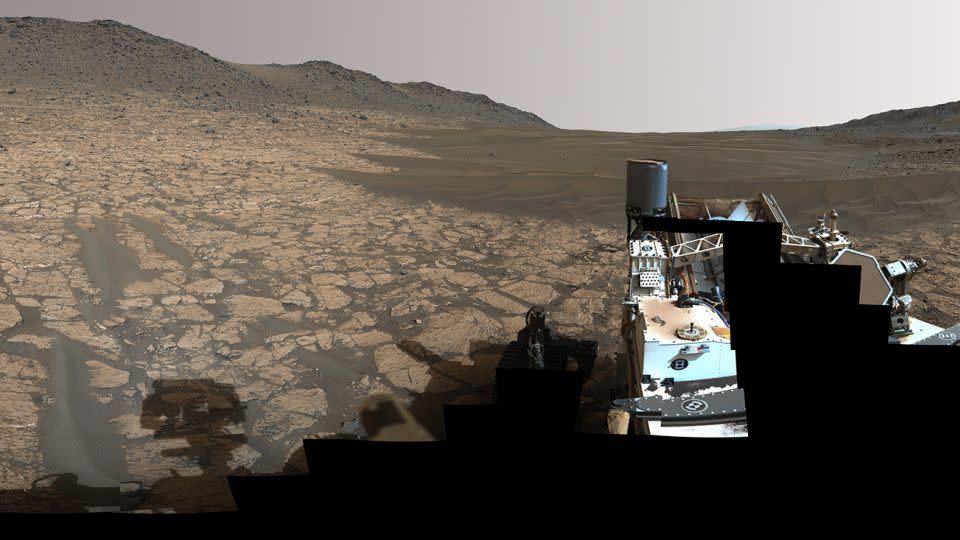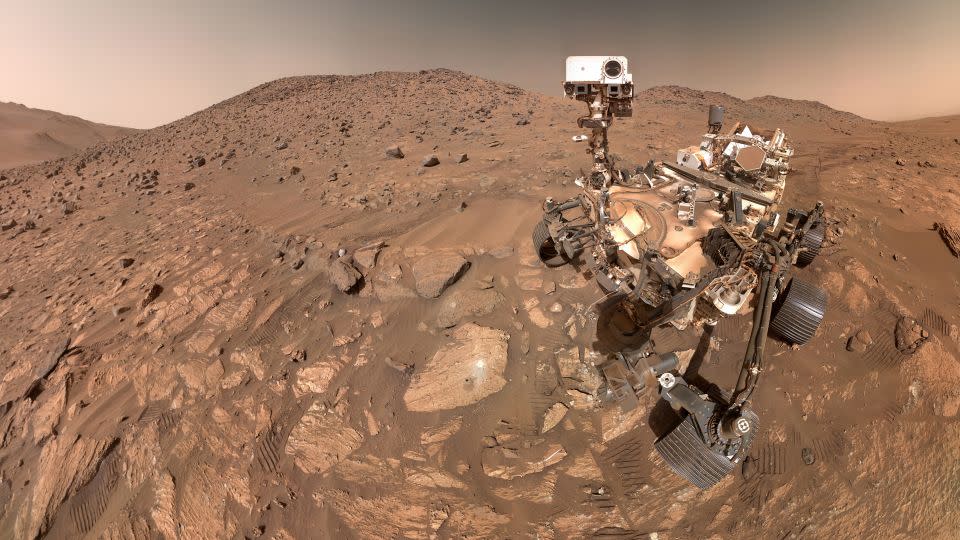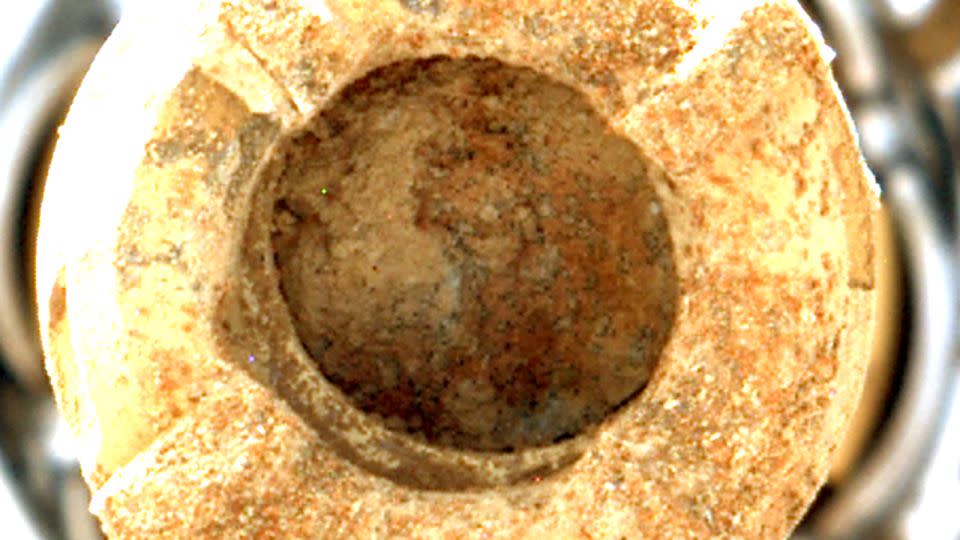Sign up for CNN’s Wonder Theory science newsletter. Explore the universe with news about fascinating discoveries, scientific breakthroughs and more.
NASA’s Perseverance rover may have found a key clue that is central to its Mars mission: geological evidence that could suggest life existed on the Red Planet billions of years ago.
The robotic explorer found a veiny red rock on July 18 that appears to be littered with leopard spots. The stains may indicate that ancient chemical reactions occurring within the rock once supported microbial organisms.
“These spots are quite a surprise,” said David Flannery, a member of NASA’s Perseverance science team and an astrobiologist at the Queensland University of Technology in Australia, in a statement. “On Earth, these types of features in rocks are often associated with the fossilized record of microbes living underground.”
The research is still preliminary and NASA scientists have not yet confirmed how the rock was created, which would require studying it on Earth. But the arrowhead-shaped specimen could help the Perseverance team discover whether Mars was once a hospitable planet for life.
“We are absolutely thrilled to have this sample in the bag!” said Briony Horgan, co-investigator on the Perseverance rover mission and professor of planetary sciences at Purdue University in West Lafayette, Indiana, in an email.
“This rock is exactly the kind of sample we came to Mars for, and we can’t wait to get it into our labs here on Earth,” she said. “This is precisely the type of potential microbial biosignature that was envisioned when NASA designed the Mars 2020 mission, and we used every instrument in our payload to find and understand this rock.”
The search for signs of ancient life on Mars
The rock, nicknamed Cheyava Falls to one of the Grand Canyon’s waterfalls, intrigues scientists for several reasons.
White veins of calcium sulfate present clear evidence that water – crucial to life – once flowed through the rock. The rover used its Scanning Habitable Environments with Raman & Luminescence for Organics & Chemicals, or SHERLOC, instrument to identify carbon-based organic molecules within rocks.
And irregularly shaped leopard spots, tested by the rover’s PIXL instrument, short for Planetary Instrument for X-ray Lithochemistry, detected iron and phosphate within the features, said Morgan Cable, a research scientist on the rover’s team, in a video shared by NASA’s Jet Propulsion Laboratory in Pasadena, California.

“We’ve never seen these three things together on Mars before,” Cable said.
The team also detected the potential presence of hematite between the white bands of calcium sulfate in the rock. Hematite is one of the minerals responsible for Mars’ characteristic red hue.
Leopard spot may have occurred when chemical reactions with hematite turned the rock from red to white, which can release iron and phosphate and potentially cause black rings to form. Such reactions can also provide an energy source for microbes.
“Cheyava Falls is the most intriguing, complex and potentially important rock ever investigated by Perseverance,” said Ken Farley, Perseverance project scientist and professor of geochemistry at the California Institute of Technology in Pasadena, in a statement.
The team also discovered millimeter-sized olivine crystals in the same rock. Olivine, previously detected In another part of Perseverance Crater, there is a mineral that forms from magma. The olivine present in the rock at Cheyava Falls may be related to rocks that formed in a different location in the valley, according to the team.
The rover team is grappling with a multitude of questions as they study the rock and try to determine what processes could have formed it.
Cheyava Falls may have started as a mixture of deposited mud and organic compounds that eventually cemented into rock. Later, water may have seeped through cracks in the rock, depositing minerals to create the calcium sulfate veins and leopard spots.
But it’s also possible that the olivine and sulfate became part of the rock due to Mars’ scorching temperatures, causing a non-biological chemical reaction that created the leopard spots.
Exploring Mars’ past
Since landing on Mars, Perseverance has crossed Jezero Crater and explored an ancient river delta in search of microfossils of past life. The rover has been collecting samples along the way that could be returned to Earth on future missions.
More recently, Perseverance has been exploring the northern edge of Neretva Vallis, an ancient river valley that once supplied water to Jezero Crater more than 3 billion years ago, and that’s where it spotted Cheyava Falls. The rover landed in the crater to explore the ancient lake in February 2021.


Geologists on the rover team were eager to have Perseverance study rocks that were created or modified by water on Mars in the past, which is why Cheyava Falls intrigued them.
“We designed Perseverance’s route to ensure it goes to areas with the potential for interesting scientific samples,” Nicola Fox, associate administrator for NASA’s Science Mission Directorate, said in a statement. “This trip along the Neretva Vallis riverbed was worth it, as we found something we have never seen before, which will give our scientists a lot to study.”
The difficult path to finding proof of life
In April, NASA said the program’s original complex, multi-mission design aimed at returning Perseverance samples to Earth, called Mars Sample Return, was is no longer viable Iin its current architecture due to budget cuts and a delay in the return date.
The agency has issued a call to NASA centers and industry to develop a new plan that combines innovation with lessons learned from proven technology. NASA leadership hopes to return samples to Earth by 2030 with less complexity, cost and risk than originally planned, and the agency expects to have answers about how best to return samples from Mars by the fall, the NASA administrator said. Bill Nelson during a press conference in April.


Meanwhile, Perseverance continues its crucial research work on Mars and will begin climbing the rim of Jezero Crater soon.
“This discovery comes at such a critical time as NASA is reconsidering the best way to obtain these samples from Mars through Mars Sample Return,” Horgan said. “This shows how important and unique our sample set is and how much we could learn about the beginning of life on Earth-like planets. It also seems very fitting that Jezero gave us one last surprise before we left the ancient river and lake sediments at the bottom of the crater and started climbing the rim.”
The Perseverance team says returning the samples is the only way to know if life ever existed on Mars.
“We destroyed that rock with lasers and X-rays and photographed it literally day and night from almost every angle imaginable,” Farley said. “Scientifically, Perseverance has nothing more to offer. To fully understand what really happened in that Martian river valley in Jezero Crater billions of years ago, we would like to bring the Cheyava Falls sample back to Earth so it can be studied with the powerful instruments available in laboratories. .”
For more news and newsletters from CNN, create an account at CNN.com


































